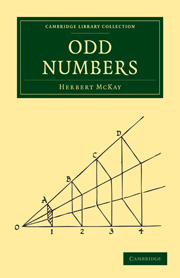Book contents
- Frontmatter
- Contents
- CINDERELLA IN GLASS SLIPPERS
- Millions & Billions & Trillions
- Great Powers & Little Powers
- How we got Logarithms
- Proportion
- Comparisons
- Proportion in Triangles
- Weights & Measures
- The Delusive Average
- Approximations
- Multiplication & Division
- Tables
- Units
- Oddities of Numbers
- The Construction & Solution of Problems
- Scales of Notation
- Frontmatter
- Contents
- CINDERELLA IN GLASS SLIPPERS
- Millions & Billions & Trillions
- Great Powers & Little Powers
- How we got Logarithms
- Proportion
- Comparisons
- Proportion in Triangles
- Weights & Measures
- The Delusive Average
- Approximations
- Multiplication & Division
- Tables
- Units
- Oddities of Numbers
- The Construction & Solution of Problems
- Scales of Notation
Summary
There are parts of arithmetic that deal with the oddities of numbers. They are seldom of any practical importance; one does them for the fun of the thing, or not at all. They are of the same order of things as poetry that is amusing and fanciful without going too deep.
I have always been glad of recurring decimals, because they brought the first touch of romance into arithmetic for me. You subtracted ·9 from 1 and you got ·00000 … with an elusive 1 that must come somewhere but that did not seem to come anywhere.
There are two kinds of oddities in numbers. Some are essential properties of the numbers. 16 objects can always be arranged as 4 fours, no matter how the number is expressed. We can write 16 as a dozen and 4(14, where the 1 stands for a dozen and not for 10) or as 2 eights (20, where the 2 stands for 2 eights); and so on. But however it is expressed 16 = 4 × 4.
A great many properties of numbers depend on the scale in which the number is expressed. Take a number at random: 873426. 8 + 7 + 3 + 4 + 2 + 6 = 30; 3 + 0 = 3. We know without further inquiry that the remainder when 873426 is divided by 9 is 3. That method and the result depend on the scale in which the number is expressed. If the number were written in powers of 12 instead of in powers of 10 the same method would apply to division by eleven.
- Type
- Chapter
- Information
- Odd Numbers , pp. 171 - 186Publisher: Cambridge University PressPrint publication year: 2009First published in: 1940

